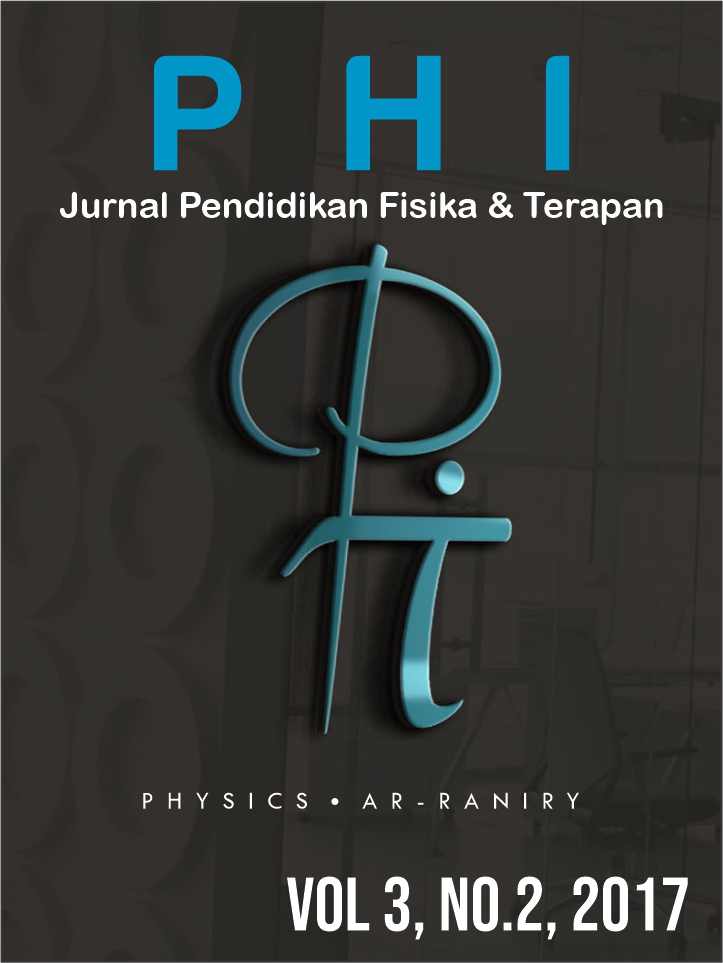Kajian Variasi Ukuran Nanopartikel Emas Melalui Metode Seed Mediated Growth
DOI:
https://doi.org/10.22373/p-jpft.v3i2.7455Abstract
Perkembangan dalam nanopartikel emas sangat menarik minat banyak peneliti untuk mengkajinya dalam berbagai bidang disebabkan sifat unik optik yang berbeda dari ukuran besarnya. Perubahan ukuran nanopartikel emas menjadi kajian dalam penelitian ini melalui variasi waktu pertumbuhannya. Adapun metode yang digunakan dalam menghasilkan nanopartikel emas adalah metode seed mediated growth untuk variasi waktu tumbuhnya 30 menit, 1 jam, 2 jam, 4 jam, 8 jam, dan 16 jam. Hasil pertumbuhan nanopartikel emas diuji karakteristik morfologinya melalui FESEM dan imaje J serta serapan optik melalui spektrometer UV-VIS. Bentuk nanopartikel emas yang didapatkan mayoritas berbentuk bulat/sperikal dengan ukuran partikelnya 25 nm, 27 nm, 31 nm, 33 nm, 35 nm, dan 47 nm. Peningkatan ukuran partikel terhadap waktu tumbuhnya dibuktikan dari pergeseran spektrum serapan optiknya yang bergeser ke daerah infra merah yaitu 536, 540, 541, 547, 550, dan 560 nm. Kesederhanaan dan kemudahaan dalam mengubah ukuran partikel emas berpeluang untuk digunakan dan dikembangkan lebih lanjut dalam pendeteksian sensor, pembuatan selReferences
Ali Umar, A., & Oyama, M. 2004.
. Crystal Growth & Design 5 (2): 599-607 Brust, M., Walker, M., Bethell, D., Schiffrin, D.J., &Whyman, R. 1994. . Journal of the Chemical Society, Chemical Communications (7): 801-802. Freeman, R.G., Grabar, K.C., Allison, K.J., Bright, R.M., Davis, J.A., Guthrie, A.P., Hommer, M.B., Jackson, M.A., Smith, P.C., Walter, D.G.&Natan, M.J. 1995. . Science 267 (5204): 1629-1632 Frens, G. 1973. . Nature Physical Science 241 (105): 20-22. Hostetler, M.J., Wingate, J.E., Zhong, C.- J., Harris, J.E., Vachet, R.W., Clark, M.R., Londono, J.D., Green, S.J., Stokes, J.J., Wignall, G.D., Glish, G.L., Porter, M.D., Evans, N.D.&Murray, R.W. 1998.
. Langmuir 14 (1): 17-30. Jiang L.-P., S. Xu, J.-M. Zhu, J.-R. Zhang, J.-J. Zhu and H.-Y. Chen. 2004. “ ” Inorg. Chem. 43, 5877-5883 Kim F., S. Connor, H. Song, T. Kuykendall and P. Yang. 2004. “ ”, Angew. Chem. Int. Ed. 43, 3673-3677 Kimling, J., Maier, M., Okenve, B., Kotaidis, V., Ballot, H., &Plech, A. 2006. The Journal of Physical Chemistry B 110 (32): 15700-15707 Nengsih, S., Ali Umar, A., Salleh, M.M., & Yahaya, M., . Key Engineering Material 495: 79-82 Nengsih, S., Ali Umar, A., Salleh, M.M., & Oyama, M. 2012. . Sensor 12:10309-10325 Nengsih, S., Ali Umar, A., Salleh, M.M., & Yahaya, M. 2011. . Sains Malaysiana 40 (3): 231-235 Nengsih, S., Ali Umar, A., Salleh, M.M., Yahaya, M., Oyama, M., &Majlis, B.Y. 2010. . Materials Science Forum 663 - 665: 956-960 Nengsih, S., Ali Umar, A., Salleh, M.M., . Advanced Material Research 364: 254-259 Schmid, G., West, H., Malm, J.-O., Bovin, J.-O., &Grenthe, C. 1996. . Chemistry–A European Journal 2 (9): 1099-1103 Umar A.A. and Oyama M., 2005. “ ,” Growth & Design, 5 (2), pp 599–607 Umar A.A, Oyama M., 2006. “ ”, Applied Surface Science 253: 2196-2206 Umar A.A. and Oyama M., 2007. “ ”, , 7 (12), pp 2404–2409 Zhou Y., C.Y. Wang, Y.R.Zhu and Z.Y.Chen. 1999. “ ”, Chem. Mater. 11, 2310- 2312
Downloads
Published
Issue
Section
License
Authors who publish with Jurnal Phi agree to the following terms:
- Authors retain copyright and grant the journal right of first publication with the work simultaneously licensed under a Creative Commons Attribution License (CC BY 4.0) that allows others to share the work with an acknowledgment of the work's authorship and initial publication in this journal.
- Authors are able to enter into separate, additional contractual arrangements for the non-exclusive distribution of the journal's published version of the work (e.g., post it to an institutional repository or publish it in a book), with an acknowledgment of its initial publication in this journal.
- Authors are permitted and encouraged to post their work online (e.g., in institutional repositories or on their website) prior to and during the submission process, as it can lead to productive exchanges, as well as earlier and greater citation of published work (See The Effect of Open Access).

















